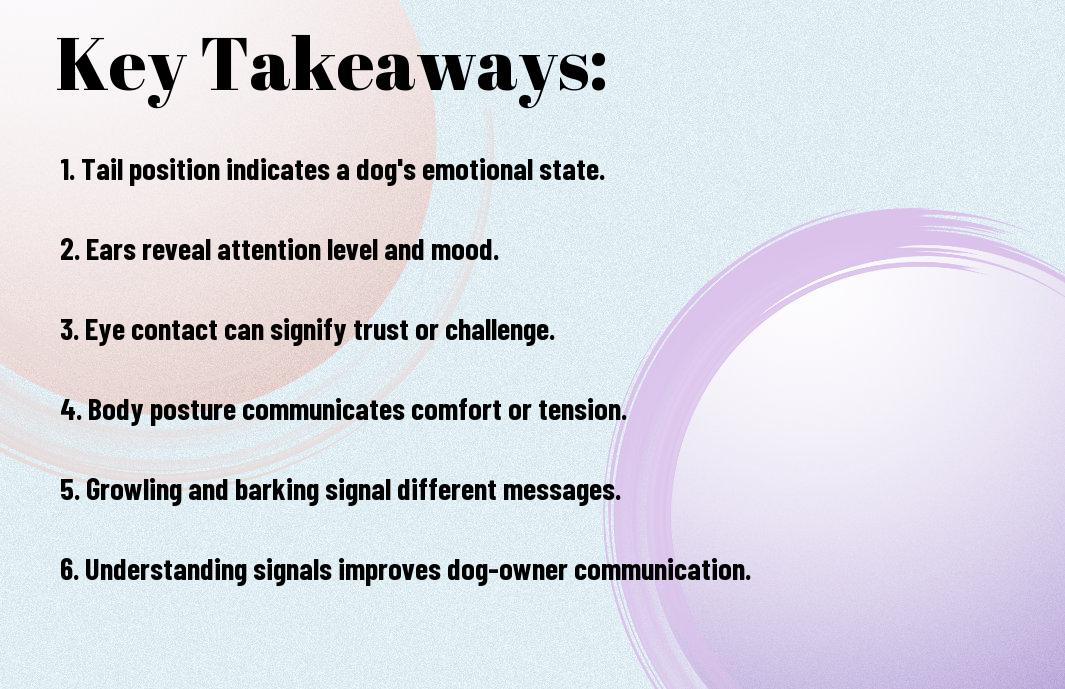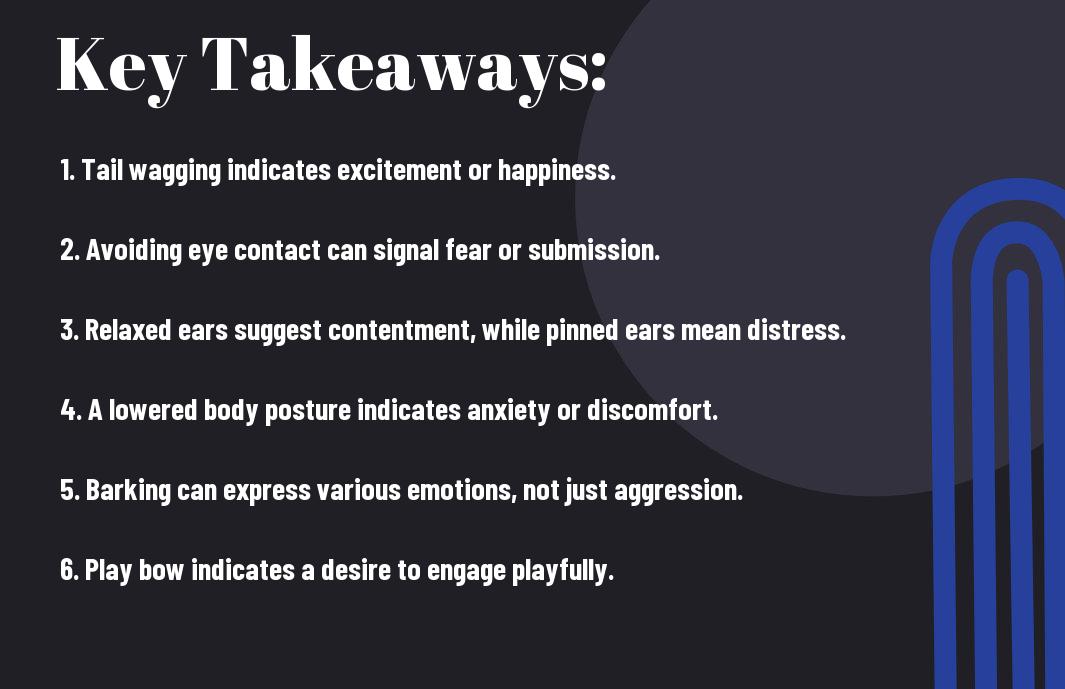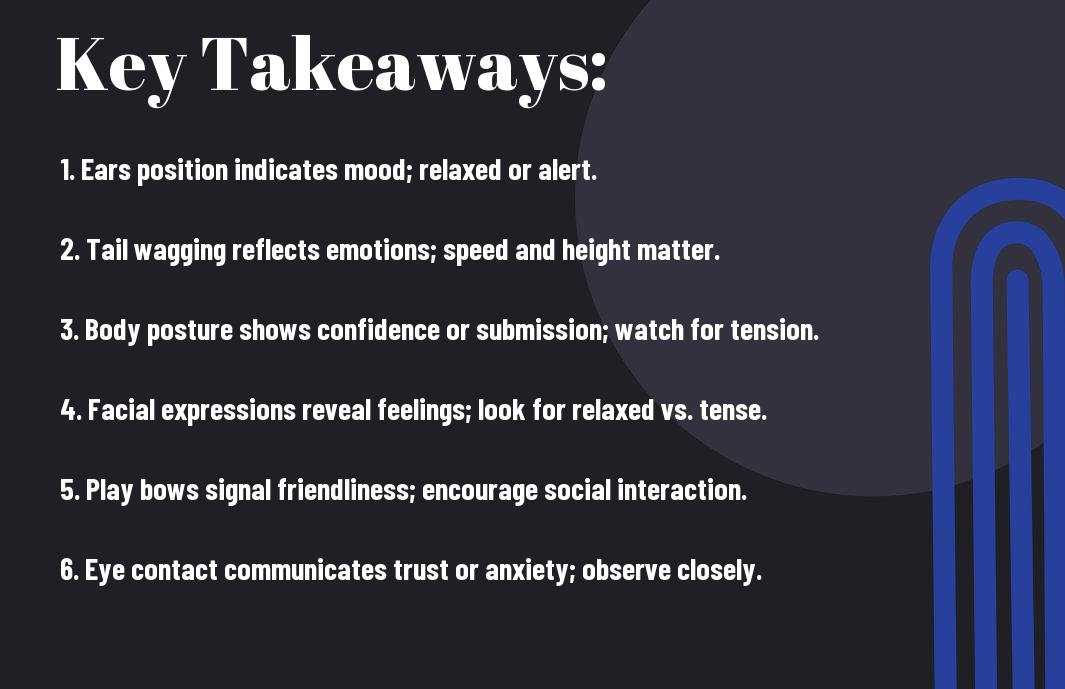It’s imperative to comprehend your dog’s body language to enhance their care and well-being. By interpreting their subtle cues and signals, you can better respond to their needs and emotions. This knowledge not only strengthens the bond between you and your furry friend but also promotes a happier, healthier life. In this post, you’ll learn how to read your dog’s posture, facial expressions, and other behaviors, allowing you to create a supportive environment tailored to their personality and feelings.

The Importance of Dog Body Language
To effectively care for your dog, it is vital to understand their body language. Your dog communicates a wealth of information through their posture, facial expressions, and gestures. By learning to interpret these signals, you can better respond to your pet’s needs, emotions, and even health concerns. Recognizing when your dog is relaxed, anxious, or excited enables you to create a more comfortable and nurturing environment that fosters a strong bond between the two of you.
Why Understanding Body Language Matters
Above all, understanding your dog’s body language plays a significant role in facilitating positive interactions. For instance, noticing signs of stress, such as tucked tails or flattened ears, allows you to intervene before a situation escalates. By being attuned to your dog’s feelings, you can provide reassurance and comfort, improving their overall well-being. Additionally, enhancing communication with your dog can deepen your relationship, as they come to trust your response to their needs.
The Connection Between Behavior and Health
Below the surface of your dog’s behavior lies a strong connection to their health. Various physical and emotional states can be reflected in the way they carry themselves and react to different situations. For example, excessive barking may point to anxiety or discomfort, while a lack of interest in play could indicate underlying health issues. Observing these behavioral cues allows you to address problems quickly, ensuring your dog receives the appropriate care when needed.
Importance of recognizing your dog’s body language goes beyond simple communication; it serves as an early warning system for potential health issues. By observing changes in your dog’s demeanor, you can identify patterns that warrant further investigation. Staying vigilant about your dog’s body language can lead to proactive health measures and enrich your shared experiences, ultimately enhancing both your dog’s quality of life and your own.
Common Canine Body Language Signals
Clearly, understanding your dog’s body language is necessary for fostering a strong bond between you and your pet. Canine body language consists of various signals that indicate how your dog is feeling at any given moment. By learning these signals, you can better interpret your dog’s emotional state and provide the appropriate care and attention they need. Below, we will explore key body language indicators including tail wagging, ear positioning, eye contact, and mouth movements.
Tail Wagging: What Different Types Mean
To start, tail wagging can convey a range of emotions, from excitement to fear. The speed, height, and direction of your dog’s tail movement can provide you with valuable insights into their mood. For instance, a high, fast wag can indicate happiness and enthusiasm, while a slow wag at a lower height might suggest uncertainty or hesitation.
| Tail Position | Meaning |
| High and Wagging | Excitement and Happiness |
| Neutral Position | Calmness |
| Low and Slow Wagging | Uncertainty or Submission |
| Fast Wagging with a Stiff Body | Agitation or Fear |
Any dog is unique, and their tail wagging can vary based on individual personality traits. Paying attention to how they wag their tail in different situations can help you make sense of their emotions and respond accordingly.
Ears: Upright, Back, and Their Meanings
About ear positioning is another fundamental aspect of understanding your dog’s emotional state. When your dog’s ears are erect and facing forward, it generally means they are alert and engaged. Conversely, if their ears are pulled back against their head, it typically stands for fear or submission. Noticing the differences in your dog’s ear placement can help you assess how they are feeling in various environments.
Meanings behind ear positioning can also depend on the situation. For example, a dog with ears perked up may be interested in what’s happening around them, whereas ears laid flat may signal discomfort or a desire to retreat. By observing these subtle signals, you can better understand your dog’s needs and actions.
Eye Contact: Direct Stares vs. Averted Gaze
For eye contact, it’s necessary to recognize that it can convey different messages based on whether your dog is staring or avoiding your gaze. A direct stare can sometimes be interpreted as a challenge or threat, whereas a relaxed, averted gaze usually signifies that your dog is feeling submissive or uneasy. Understanding these dynamics helps you interpret your interaction with your dog correctly.
Contact with your dog’s eyes during interactions is equally important. If your dog maintains soft eye contact, it can indicate affection and trust. However, if they are averting their gaze quickly, they may feel threatened or anxious. Keeping an eye on these signals can help you support your dog in understanding their comfort zone.
Mouth Movements: Smiling vs. Snarling
Different mouth movements can provide significant insight into your dog’s emotional landscape. A relaxed, open mouth with a slightly lolling tongue often signifies that your dog is content and happy. On the other hand, a tight-lipped look or exposed teeth can be the start of aggressive behavior or fear, indicating the need for caution. Knowing how to read these expressions can help you navigate potential scenarios effectively.
This knowledge about mouth movements allows you to respond to your dog’s feelings appropriately. For instance, a dog showing signs of a snarl may be feeling defensive, and you should give them the space they need in those moments. Understanding these cues means you can ensure both your safety and your dog’s comfort.
Understanding Fear and Anxiety in Dogs
Unlike humans, dogs cannot verbally express their feelings, making it necessary for you to decode their body language to understand what they are experiencing. Fear and anxiety can manifest in various ways and can significantly affect your dog’s behavior and overall well-being. By recognizing the signs, you can take appropriate measures to support your furry friend and create a more comfortable environment for them.
Identifying Signs of Stress
Among the common signs that indicate your dog may be stressed are changes in their behavior, such as excessive barking, panting, or pacing. Additionally, you might notice that your dog tends to hide or seek shelter in closed spaces, which can be alarming yet informative. Pay attention to their body posture; if they seem tense, their tail is lower than usual, or their ears are pinned back, these signs can highlight their anxiety levels. By being vigilant and observant, you become attuned to fluctuating emotions that impact their overall mood and interactions with the environment.
Body Language of Fearful Dogs
At times, your dog may exhibit an array of physical cues when they are feeling fearful. For example, a low tail carriage, wide eyes, or submissive body posture (like crouching) are clear indications that they are experiencing fear. Additionally, a dog that is scared might try to avoid eye contact or even attempt to make themselves look smaller by tucking their hindquarters. It’s vital to take note of these signals, as they can reveal your dog’s state of mind in any given situation, helping you to respond appropriately.
Considering your dog’s fear response, it is important to recognize that these signs are not simply moments of shyness but rather indicators that they may be under stress. Just as with humans, prolonged exposure to stress can lead to adverse effects on your dog’s health and behavior. Your dog looks to you for guidance and reassurance during these times, so understanding their body language can help you foster a safer and more secure environment.
How to Respond to a Fearful Dog
Below are some steps you can take to help support a fearful dog. First and foremost, provide them with a safe space where they can retreat and feel secure. It could be a comfortable bed in a quiet corner or a designated “safe zone” where they know they will not be disturbed. Avoid forcing them to confront fears, as this may exacerbate their anxiety. Instead, use calm cues and positive reinforcement to encourage more confident behavior when your dog is exposed to whatever triggers their fear.
Understanding your dog’s fear response will empower you to appropriately react to their needs. Focus on positive experiences and gradually desensitize them to situations that cause fear, allowing them to associate these experiences with safety and comfort. Consulting with a professional dog trainer or animal behaviorist can also provide you with tailored strategies to help your dog overcome their fears effectively.

Signs of Aggression and Warning Signals
Now that you have learned about how to read your dog’s body language, it’s important to identify specific signs of aggression and the warning signals they may display. Understanding these cues can significantly enhance your relationship with your dog and ensure their well-being, as well as the safety of those around them.
Postures Indicating Aggression
Among the various signs of aggression, specific postures can indicate that your dog is feeling threatened or defensive. You should look for a stiff body, raised hackles, and a tense jaw. If your dog’s tail is held high and rigid, and their ears are pointed and forward, they are likely in an aggressive state. These physical signs suggest that your dog feels the need to assert themselves and may be preparing to react in a way that could be harmful.
Additionally, if your dog is crouched with a low head and their body language appears uncomfortable, this could also indicate that they are ready to defend themselves. A dog poised to act aggressively might also display a deep, curled lip and show their teeth, which is an unmistakable warning that they feel provoked.
Understanding Growls and Snaps
One of the most recognizable signs of aggression is a growl. Growls can vary in intensity and meaning, so it’s vital to understand the context in which your dog growls. A low, rumbling growl may indicate discomfort or displeasure with a situation or person, whereas a high-pitched growl may suggest fear or anxiety. It’s important to pay attention to these variations in sound and the accompanying body language to assess the situation accurately.
Snapping, or a quick bite with no intent to injure, is another form of communication that dogs use when they feel threatened or annoyed. It serves as a final warning before they may resort to biting. You must take these signals seriously as they can indicate that your dog is not comfortable and needs space.
Plus, it’s beneficial to recognize that not all growls signify aggression; some may come from excitement or play. Understanding the nuanced meanings behind these vocalizations allows you to respond appropriately and helps prevent escalation of aggression.
Prevention and Management of Aggression
Above all, managing your dog’s aggression effectively relies on early intervention and understanding. Creating a safe environment, implementing consistent training, and socializing your dog can significantly reduce the likelihood of aggressive behavior. Responding to their body language and vocal signals promptly can help you defuse potentially dangerous situations.
It’s important to approach any signs of aggression with sensitivity and a proactive mindset. You may want to consider working with a professional trainer or behaviorist if your dog exhibits aggressive tendencies, especially if they are unprovoked. Training focused on positive reinforcement can help reshape your dog’s behavior in a healthy way.
In fact, addressing aggression early on can help you avoid situations where your dog feels they need to defend themselves. By recognizing the warning signals and taking preventative measures, you can foster a more harmonious relationship with your dog and promote a peaceful environment for everyone involved.
Reading Relaxed and Happy Dogs
After spending time with your dog, it becomes imperative to understand when they feel at ease and content. Observing their body language can provide you with valuable insights into their emotions, allowing you to better care for them. Happy dogs exhibit various signs that indicate their comfort, helping you create a more harmonious environment for both of you.
Signs of Comfort and Relaxation
To accurately interpret your dog’s body language, look for signs of comfort and relaxation. A dog that is feeling good will often have a loose and wagging tail, with soft eyes and a relaxed stance. Their ears may be neutral or slightly raised instead of being pulled back close to their head. Additionally, many dogs will exhibit behaviors such as lying down with their belly exposed, which shows that they feel safe in their surroundings.
This relaxed demeanor not only indicates their happiness but also fosters a positive bond between you and your furry friend. When you notice these signs, it’s a great opportunity to engage in activities that strengthen your relationship, such as petting or gentle playtime. Recognizing these signs can enhance your dog’s overall well-being, tailoring your interactions to their emotional state.
Play Bow and Other Playful Behaviors
One of the most recognizable playful behaviors is the “play bow,” where your dog lowers their front legs while keeping their rear end up, often accompanied by an excited wagging tail. This particular posture invites interaction and play, signaling that your dog is in a friendly and fun-loving mood. You may also notice them exhibiting behaviors such as bouncing around, running in circles, or playfully nipping at you or a toy.
Engaging with your dog during these moments can lead to joyful interactions and strengthens the bond between you. By responding to their play bow with enthusiasm, you’re acknowledging their desire for companionship and fun. Encouraging this playful side also offers them an outlet for their energy, facilitating both mental and physical stimulation.
The Role of Body Language in Social Interactions
One of the imperative aspects of understanding your dog is recognizing how body language plays a significant role in their social interactions. As a pet owner, being attentive to your dog’s various postures and facial expressions can help you gauge their comfort level, both with you and with other pets. You may notice them engaging in more relaxed behaviors when they feel at ease in a social situation, which can be reflected in their overall demeanor.
By observing and understanding these social cues, you can better facilitate positive interactions with other dogs and people. A dog that displays relaxed body language is more likely to enjoy playdates or outings, reducing the chances of conflict or anxiety. Not only does this foster a healthy social environment, but it also assures your dog that they can trust you to recognize their feelings.
A dog’s comfort and happiness are paramount for their overall well-being. By honing in on specific behavioral cues and engaging positively during these moments, you can nurture a deeper understanding of your dog’s emotional landscape, leading to a more harmonious life together.

The Effects of Environment on Dog Body Language
Keep in mind that the environment your dog is in can significantly influence their body language and behavior. When you take your dog to a park, for example, the sights, sounds, and smells can stimulate them in ways that a quiet home environment cannot. This heightened sensory input can cause your dog to be more alert, excited, or even anxious, depending on their personality and past experiences. Understanding how to interpret their body language in different settings can help you respond appropriately to their needs and keep them comfortable.
How Different Settings Influence Behavior
Behind every wag of the tail or posture shift lies a response to the surroundings your dog finds themselves in. In busy, crowded areas, you might notice your dog leaning away from strangers or tucking their tail beneath them, signaling discomfort or anxiety. Meanwhile, in a familiar setting like your backyard, you may observe your dog exhibiting more relaxed behavior, such as lying down with their belly exposed, which indicates they feel safe and secure. This variance in behavior can offer valuable insights into how your dog is coping with each environment.
Recognizing Overstimulation and Fatigue
After a day filled with excitement, your dog may exhibit signs of overstimulation or fatigue, which can manifest through various body language cues. You might notice them panting excessively, pacing back and forth, or even lying down with a reluctance to engage. Recognizing these signs is vital, as it indicates your dog may need a moment to decompress or even take a break from the current environment. Acting on these cues can help you foster a more positive experience and prevent stress from building up.
Another key sign of overstimulation is the alertness in their ears and tail. While a dog’s tail might be wagging in excitement, if it starts to become stiff and high, coupled with flattened ears, this could suggest that they are overwhelmed. Being attentive to these changes can make all the difference in how you navigate your dog’s needs during various outings.
Adapting Your Approach to Different Situations
Between adjusting your plans and knowing when to give your dog space, adapting your approach to different situations is crucial for their well-being. For example, if your dog seems nervous in a new environment, you might choose to engage in calming exercises or use positive reinforcement to build their confidence. Conversely, in stimulating settings, you can help your dog manage their enthusiasm through structured activities like training sessions or controlled playdates.
Consequently, being flexible and willing to change your approach can lead to a healthier relationship with your dog. This adaptability allows you to respond more effectively to your dog’s needs, ensuring that they receive the appropriate care, attention, and support they require in any given situation. By recognizing the impact of different environments on your dog’s body language, you empower yourself to be the best advocate for their well-being.
Training and Socialization: Enhancing Understanding
Once again, it is imperative to emphasize that training and socialization play vital roles in how your dog communicates with you and others. Training your dog not only involves teaching commands but also encompasses understanding and responding appropriately to their body language. When you reinforce positive body language through training techniques, you help your dog feel more secure and confident, allowing for better communication between you both.
Teaching Dogs Positive Body Language
Dogs are naturally expressive creatures, and their body language is a fundamental aspect of how they convey their feelings and emotions. By teaching your dog to exhibit positive body language—such as sitting calmly, maintaining a relaxed posture, or displaying a soft gaze—you help create an environment where effective communication can flourish. This not only promotes a healthy bond between you and your dog but also encourages socialization with other pets and people.
As you work on teaching your dog these positive cues, ensure that you reward them for their achievements. Using treats, praise, or play as incentives can lead to a happier, more engaged dog. This engagement can significantly enhance your dog’s understanding of social interactions, making them more adept at communicating with their surroundings.
The Role of Consistency in Training
At the heart of effective training is consistency. Your dog relies on predictable cues to understand what is expected of them and how to behave in different situations. When you establish consistent rules and signals, your dog learns the connection between actions and consequences. This understanding deepens their trust in you and enhances their ability to express positive body language.
But consistency is not just about adhering to commands; it’s also about responding appropriately to your dog’s body language. If you are inconsistent in interpreting their signals—such as ascribing different meanings to tail wags or barks—your dog may become confused or anxious. By aligning your responses with your dog’s communicative signals, you create a harmonious relationship that fosters trust and clarity.
Building Trust through Non-Verbal Communication
Among the many aspects of dog training that can significantly improve your bond with your pet, non-verbal communication is particularly powerful. By being aware of your own body language and how it interacts with your dog’s signals, you can create an environment that promotes trust and security. Simple actions such as approaching your dog calmly, maintaining a relaxed stance, and using open gestures communicate safety and reassurance.
Body language is a two-way street; being attuned to your dog’s signals fosters mutual understanding. For example, if your dog seems hesitant or afraid, acknowledging their feelings and adjusting your posture can help ease their anxiety. This attentiveness not only builds trust but also enhances your dog’s overall behavior and willingness to engage positively with the world around them.
Q: How can I interpret my dog’s tail movements?
A: The position and movement of your dog’s tail can convey a lot about their feelings. A wagging tail usually signifies happiness or excitement, but the speed and direction of the wag can vary. For instance, a tail that wags quickly and is held high often indicates confidence and joy, while a slow wag at a lower position might show uncertainty or uncertainty. However, if the tail is tucked between their legs, it can signal fear or submission. Observing the context in which these tail movements occur will give you better insights into your dog’s emotional state.
Q: What does it mean if my dog is avoiding eye contact?
A: Avoiding eye contact can indicate that your dog is feeling anxious, submissive, or uncomfortable. Dogs naturally use body language to communicate their feelings, and prolonged staring can be perceived as a challenge or threat. If your dog is looking away, yawning, or turning their head to the side, they may be signaling that they prefer to disengage from the situation or interaction. It’s beneficial to respect this behavior, as forcing eye contact or interaction can escalate their discomfort.
Q: Why does my dog roll over onto their back?
A: When your dog rolls onto their back, it can indicate a few different things, depending on the context. If they approach you and roll onto their back, this is often a sign of trust and submission, showing that they feel safe with you. However, if your dog rolls onto their back and seems tense or is growling, it might indicate a defensive posture, signaling that they feel threatened. Pay attention to other body language cues, such as facial expressions and overall body tension, to get a complete understanding of why they are displaying this behavior.










